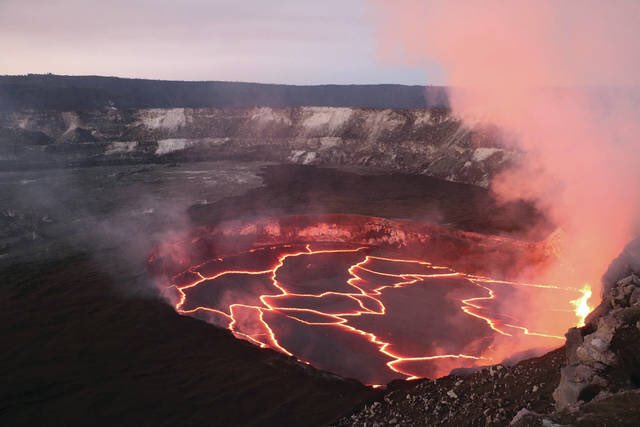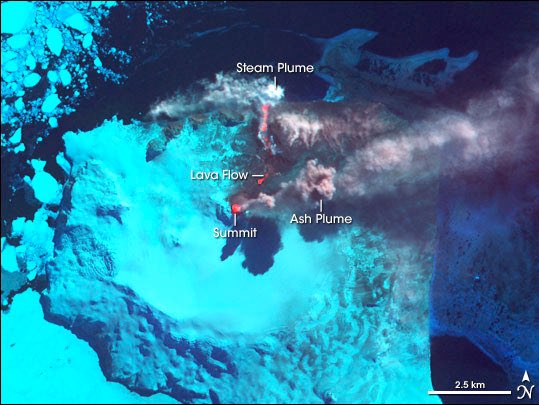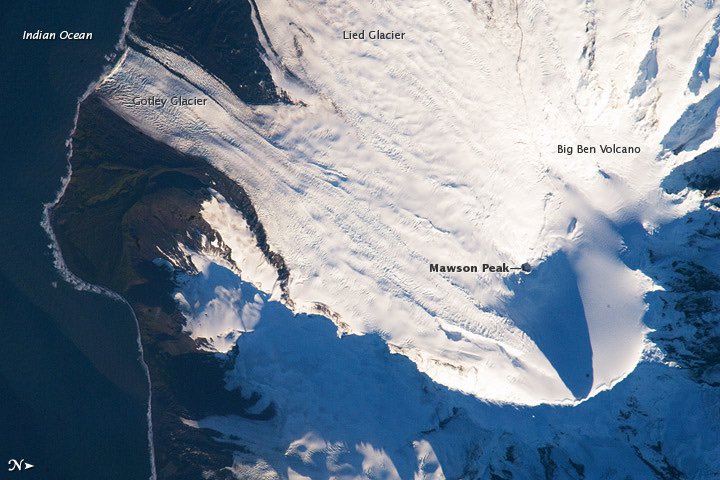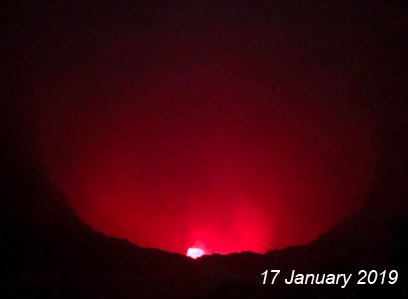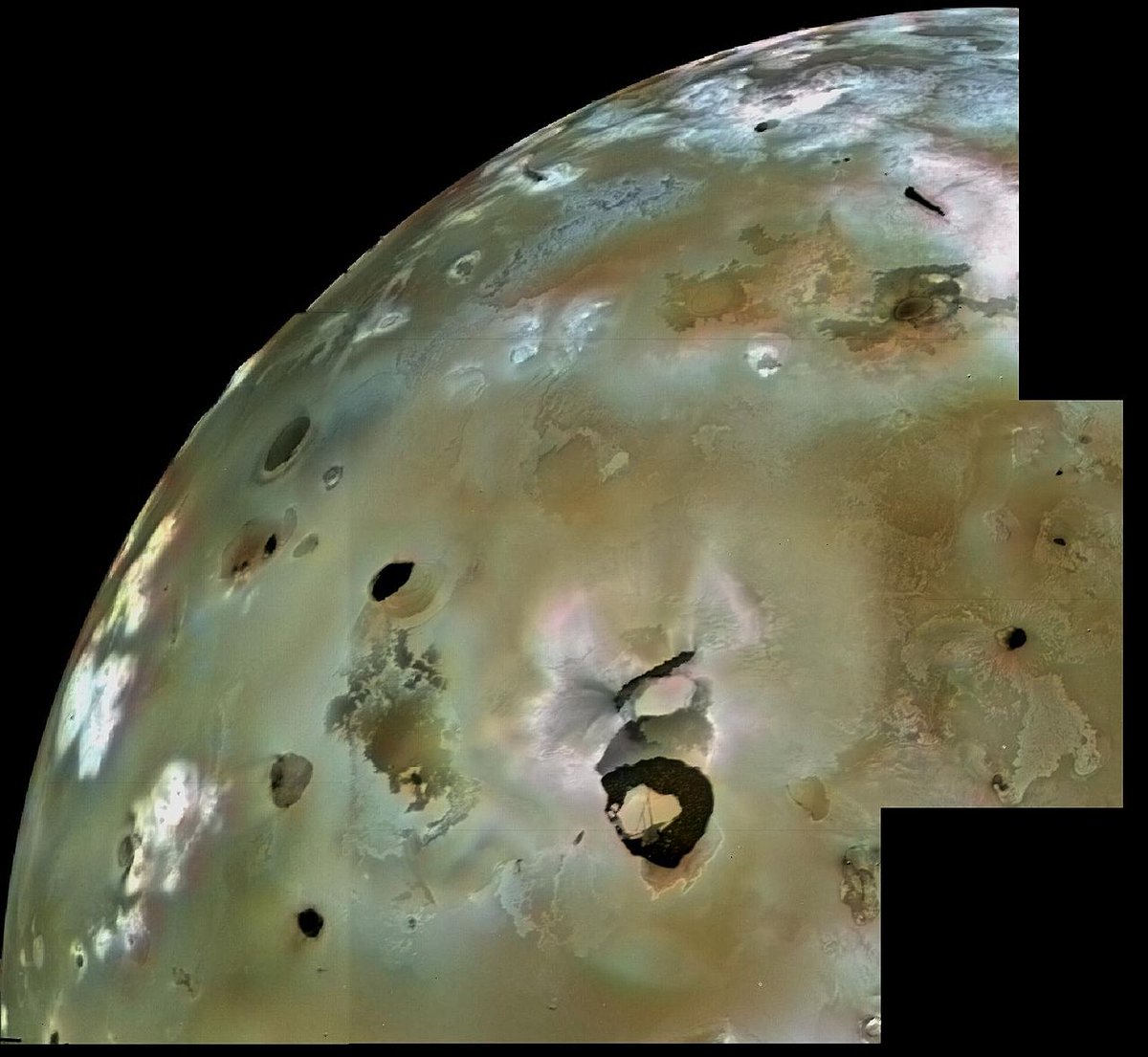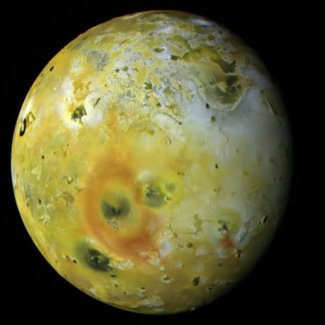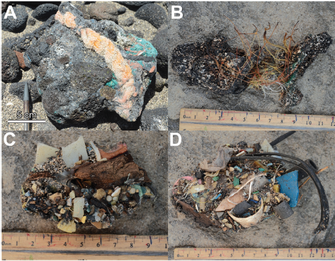Hawaii almost always has lava lakes. At least, it did.
Both Kīlauea‘a persistent lava lakes drained during its May 2018 eruptions. Halemaumau (home of Pele) even has park observation structures for lava-watching, but today it’s empty.
For now. Maybe not tomorrow.
 USGS 2017
USGS 2017
Both Kīlauea‘a persistent lava lakes drained during its May 2018 eruptions. Halemaumau (home of Pele) even has park observation structures for lava-watching, but today it’s empty.
For now. Maybe not tomorrow.
 USGS 2017
USGS 2017
Q: What do you mean by “7ish”? It’s either 7 lava lakes or it’s not!
A: Turns out the Earth is REALLY big, & some volcanoes are difficult to visit.
From infrared satellite, Mt Belinda (near-ish Mt Michael) & Mawson Peak (Heard Island) may have lava lakes but maybe not?
 NASA
NASA
A: Turns out the Earth is REALLY big, & some volcanoes are difficult to visit.
From infrared satellite, Mt Belinda (near-ish Mt Michael) & Mawson Peak (Heard Island) may have lava lakes but maybe not?
 NASA
NASA
Masaya lava lake (Nicaragua) is a wee baby in modern context, only showing up in 2016.
Except it was also around when the Spanish Conquistadors were tromping around, and was probably full off&on for the last 2,500 years.
“Persistent” is wonky on geologic time.
 Alun Ebenezer
Alun Ebenezer
Except it was also around when the Spanish Conquistadors were tromping around, and was probably full off&on for the last 2,500 years.
“Persistent” is wonky on geologic time.
 Alun Ebenezer
Alun Ebenezer
For right now, Nyiragongo (Republic of Congo) is home to the world’s largest lava lake.
Remember that viral vid of the volcanologist getting too close when sampling lava & needing to flee? That was Nyiragongo.
Remember that viral vid of the volcanologist getting too close when sampling lava & needing to flee? That was Nyiragongo.
You also probably know Erta Ale (Ethiopia), Perseus’s entry to the underworld from Clash of the Titans.
...or the starring lava lake in that viral vid where garbage is chucked into a lava lake then the lake belches back in a lava fountain.
...or the starring lava lake in that viral vid where garbage is chucked into a lava lake then the lake belches back in a lava fountain.
Mount Erebus (Antartica) is my fav.
The lava lake itself is normal, but all the outgassing heats up snow enough to make ice caves & towering fumaroles. Deadly but gorgeous with hardcore extremophiles.
Read more: https://www.atlasobscura.com/places/mt-erebus & https://www.smithsonianmag.com/travel/antarctica-erupts-140405968/
The lava lake itself is normal, but all the outgassing heats up snow enough to make ice caves & towering fumaroles. Deadly but gorgeous with hardcore extremophiles.

Read more: https://www.atlasobscura.com/places/mt-erebus & https://www.smithsonianmag.com/travel/antarctica-erupts-140405968/
In recent times, we've spotted lava lakes, lava ponds, & lava puddles at Villarrica (Chile), Karthala (Comoros), Ol Doinyo Lengai (Tanzania), Turrialba (Costa Rica), & Piton de la Fournaise (Réunion Island)
Consistency isn't exactly a strong suit for volcanoes.
Consistency isn't exactly a strong suit for volcanoes.
Geologically recent (human time) but now-drained lava lakes include Ardoukôba (Djibouti), Nyamuragira (DRC), Capelinhos (Iceland), Etna & Mt Vesuvius & Stromboli (Italy), Mt Mihara (Japan), La Cumbre (Galápagos), Pacaya (Guatemala), Tolbachik (Russia), & Mt Matavanu (Samoa)
We also have a list of suspected recent-but-unconfirmed lava lakes: Tungurahua (Ecuador maybe in 1999), Nabro (Eritrea maybe in 2012), Telica (Nicaragua maybe in 1971 & 1999–2000), & Tofua (Tonga maybe in 2004 & 2006)
I think that's all the major Earthly lava lakes?
I think that's all the major Earthly lava lakes?
Q: Wait, can we get lava lakes elsewhere in the solar system??
A: YES! Remember Io, Jupiter's ridiculously volcanically active moon? You know it's got lava lakes goin' on.
 NASA 1997
NASA 1997
A: YES! Remember Io, Jupiter's ridiculously volcanically active moon? You know it's got lava lakes goin' on.
 NASA 1997
NASA 1997
Io's lava lakes (paterae) may have totally different geological mechanisms than our terrestrial lava lakes ( https://agupubs.onlinelibrary.wiley.com/doi/abs/10.1029/2000JE001406). That's still TBD.
Paterae are very hot scallop-edged craters & usually have a thin skin of frequently-resurfacing crust.
 NASA 1979
NASA 1979
Paterae are very hot scallop-edged craters & usually have a thin skin of frequently-resurfacing crust.
 NASA 1979
NASA 1979
Without ground verification & continuous monitoring, Io's lava lakes are very "ish.
Io's largest lava lake is Loki Patera, but thermally behaves kinda like a mid-ocean ridge? TBD.
Janus Patera & Pele (red ring) look thermally identical to terrestrial lava lakes.
 NASA 1999
NASA 1999
Io's largest lava lake is Loki Patera, but thermally behaves kinda like a mid-ocean ridge? TBD.
Janus Patera & Pele (red ring) look thermally identical to terrestrial lava lakes.
 NASA 1999
NASA 1999
We haven't spotted active lava lakes elsewhere in the solar system, but Janus & Pele are both in fluctus, the fancy astronomy term for lava flow fields.
And that's interesting because we've found fluctus on Mars, Venus, Titan, so they may've previously had lava lakes. Oooh!
And that's interesting because we've found fluctus on Mars, Venus, Titan, so they may've previously had lava lakes. Oooh!
But what I really love about lava lakes?
They happen with literally every geochemistry & volcanic setting. Gentle shield volcanoes, violent stratovolcanoes, big ol' calderas, wee cinder cones, even the only active carbonatite volcano. Lava lakes for everyone!
They happen with literally every geochemistry & volcanic setting. Gentle shield volcanoes, violent stratovolcanoes, big ol' calderas, wee cinder cones, even the only active carbonatite volcano. Lava lakes for everyone!
Q: Um. This is silly, but... what exactly is a lava lake?
A: A lava lake is any surface puddle of melty rock goo. It can be fully or partly molten, with or without a crusty skin, and may be calm or raging.
If it's mostly cooled & solidified, it's a frozen lava lake.
A: A lava lake is any surface puddle of melty rock goo. It can be fully or partly molten, with or without a crusty skin, and may be calm or raging.
If it's mostly cooled & solidified, it's a frozen lava lake.
Lava lakes form when an eruption fills a crater. This happens by:
1. An eruption inside a crater fills it,
2. An eruption creates new crater then fills it, or
3. An eruption spills into a crater and fills it.
it can be 1-time or cycling (drain & refill)
1. An eruption inside a crater fills it,
2. An eruption creates new crater then fills it, or
3. An eruption spills into a crater and fills it.
it can be 1-time or cycling (drain & refill)
Lava lake cycling is a whole 'nother level of weird.
Some volcanoes maintain a near-steady levels (Mauna Ulu, Kīlauea), while others rise & fall (Pu'u 'O'o, Kīlauea on a 15-20min cycle) depending on how bubbles releas gas from the lake lava and magma in its conduit & reservoir.
Some volcanoes maintain a near-steady levels (Mauna Ulu, Kīlauea), while others rise & fall (Pu'u 'O'o, Kīlauea on a 15-20min cycle) depending on how bubbles releas gas from the lake lava and magma in its conduit & reservoir.
Q: What happens if a human falls into lava?
A: @eruptionsblog has you covered: https://www.wired.com/2011/12/the-right-and-wrong-way-to-die-when-you-fall-into-lava/
In essence: You'd get burned horrendously & totally die, but you'd float as you're less dense than rock.
A: @eruptionsblog has you covered: https://www.wired.com/2011/12/the-right-and-wrong-way-to-die-when-you-fall-into-lava/
In essence: You'd get burned horrendously & totally die, but you'd float as you're less dense than rock.
Q: Minecraft says I'm gonna get diamonds! Where are the diamonds?
A: Diamonds are carried to the surface by kimberlite pipe eruptions, which haven't happened during human existence. But yes, we DO think they form lava lakes!
Learn more: https://www.sciencefocus.com/planet-earth/earths-hidden-ocean/
A: Diamonds are carried to the surface by kimberlite pipe eruptions, which haven't happened during human existence. But yes, we DO think they form lava lakes!
Learn more: https://www.sciencefocus.com/planet-earth/earths-hidden-ocean/
Q: This is why you don't dig straight down!
A: Ohhhh, geoscientists would be SO EXCITED if we could dig down to magma. We've never made it through even the thinest crust with our deepest boreholes.
More: https://twitter.com/mikamckinnon/status/1133852046891765760
A: Ohhhh, geoscientists would be SO EXCITED if we could dig down to magma. We've never made it through even the thinest crust with our deepest boreholes.
More: https://twitter.com/mikamckinnon/status/1133852046891765760
Q: Hey, how do scientists sample lava?
A: Once again, Minecraft cribs from real life: volcanologists use a rock hammer to dump fresh lava in a bucket.
Learn more: https://gizmodo.com/how-do-you-collect-samples-from-an-active-volcano-1735782256
A: Once again, Minecraft cribs from real life: volcanologists use a rock hammer to dump fresh lava in a bucket.
Learn more: https://gizmodo.com/how-do-you-collect-samples-from-an-active-volcano-1735782256
Q: Is this how we get lava cakes?
A: Nah, but @SyracuseLava & @BompasandParr once cooked steaks on an artificial research lava flow. Please do NOT try this at home; molten rock is totally gonna break your rental agreement.
Learn more:
https://www.sciencealert.com/watch-scientists-cook-the-perfect-steak-with-lava
A: Nah, but @SyracuseLava & @BompasandParr once cooked steaks on an artificial research lava flow. Please do NOT try this at home; molten rock is totally gonna break your rental agreement.
Learn more:
https://www.sciencealert.com/watch-scientists-cook-the-perfect-steak-with-lava
Q: No, but really, couldn't I just... dip a toe in?
A: Pretty much everyone who has fallen even NEAR a lava lake has died from toxic gas, impact trauma, or if they manage to actually fall into lava, burning.
It's a whole lot of depressing stories of people dying. Pls no.
A: Pretty much everyone who has fallen even NEAR a lava lake has died from toxic gas, impact trauma, or if they manage to actually fall into lava, burning.
It's a whole lot of depressing stories of people dying. Pls no.
Q: You said "Pretty much everyone." Spill!
A: In 2007, a local Maasai porter at Ol Doinyo Lengai (Tanzania https://volcano.si.edu/showreport.cfm?doi=10.5479/si.GVP.BGVN200802-222120) slipped into a lava puddle. Cooler temperature of carbonate lava allowed him to survive, but with severe injuries: http://blogs.stlawu.edu/lengai/tragic-accident-in-2007/
A: In 2007, a local Maasai porter at Ol Doinyo Lengai (Tanzania https://volcano.si.edu/showreport.cfm?doi=10.5479/si.GVP.BGVN200802-222120) slipped into a lava puddle. Cooler temperature of carbonate lava allowed him to survive, but with severe injuries: http://blogs.stlawu.edu/lengai/tragic-accident-in-2007/
Q: That was a shitty story & now I'm sad.
A: Hawaii's gooier lava is really hot, but it cools quickly enough that volcanologists sometimes dash across not-entirely-cool lava flows. It leads to a lot of melty boots.
Pls do NOT try this, just enjoy the '70s fashion.
A: Hawaii's gooier lava is really hot, but it cools quickly enough that volcanologists sometimes dash across not-entirely-cool lava flows. It leads to a lot of melty boots.
Pls do NOT try this, just enjoy the '70s fashion.
Q: No, but really! Could we just throw all our trash into volcanoes?
A: Nope. Main problems:
1. Volcanoes are dangerous
2. We create a LOT of garbage
3. Even calm lava lakes erupt into lava fountains
Learn more in @MaryBethGriggs's article: https://www.popsci.com/why-dont-we-just-throw-all-our-garbage-into-volcanos/
A: Nope. Main problems:
1. Volcanoes are dangerous
2. We create a LOT of garbage
3. Even calm lava lakes erupt into lava fountains
Learn more in @MaryBethGriggs's article: https://www.popsci.com/why-dont-we-just-throw-all-our-garbage-into-volcanos/
Related: We're starting to find rocks WITH PLASTIC IN THEM on beaches in Hawaii.
They're plastiglomerate, conglomerates (sedimentary rocks made of smaller rocks) incorporating molten plastic (possibly from campfires).
More: https://www.sciencemag.org/news/2014/06/rocks-made-plastic-found-hawaiian-beach
 P Corcoran/C Moore/K Jazvac
P Corcoran/C Moore/K Jazvac
They're plastiglomerate, conglomerates (sedimentary rocks made of smaller rocks) incorporating molten plastic (possibly from campfires).
More: https://www.sciencemag.org/news/2014/06/rocks-made-plastic-found-hawaiian-beach
 P Corcoran/C Moore/K Jazvac
P Corcoran/C Moore/K Jazvac

 Read on Twitter
Read on Twitter